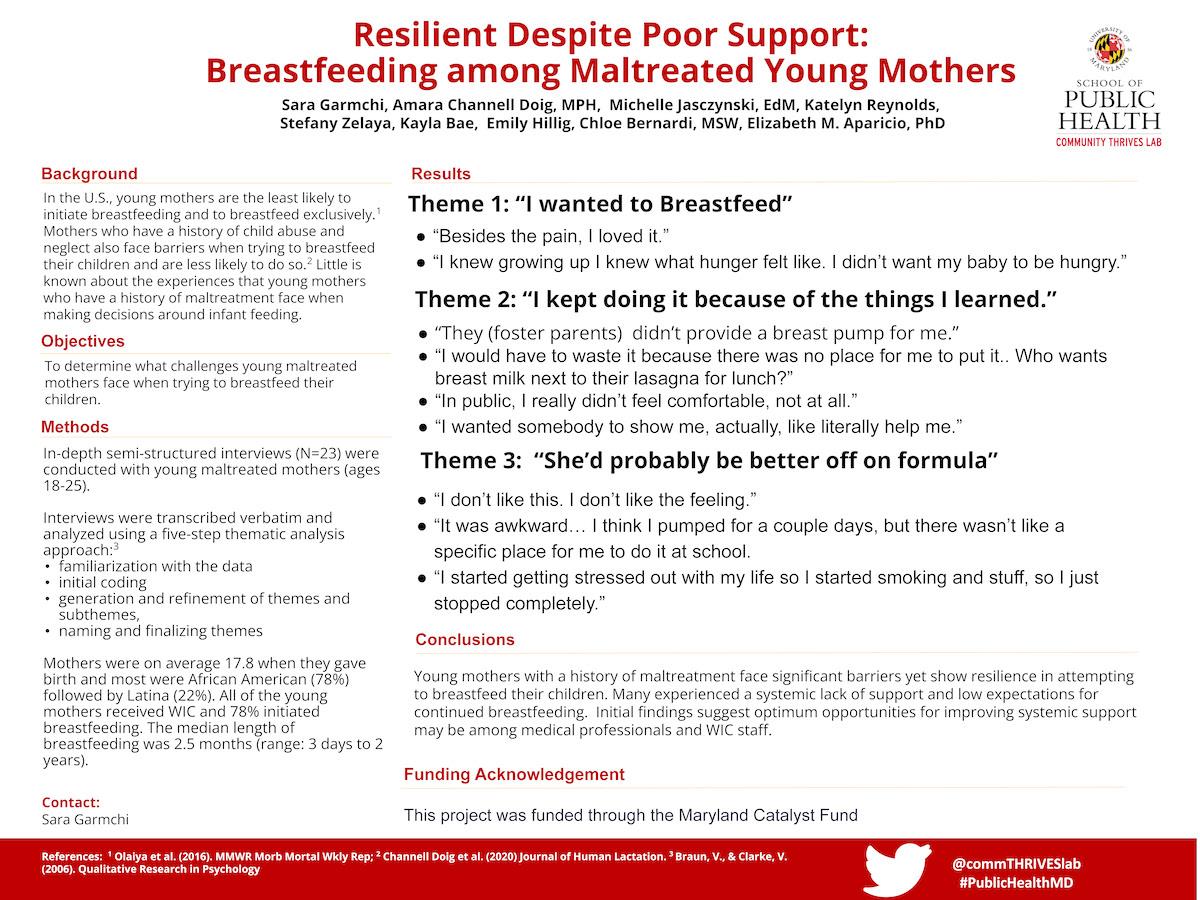
Poster # 27
Title: Resilient Despite Poor Support: Breastfeeding among Maltreated Young Mothers
Presenting Author: Sara Garmchi (UMD Undergraduate Student, Psychology)
Authors: Amara Channell Doig, Department of Behavioral & Community Health, University of Maryland, College Park, Ph.D. Candidate; Michelle Jasczynski, Department of Behavioral & Community Health, University of Maryland, College Park, Ph.D. Candidate; Katelyn Reynolds, Biological Sciences - Physiology and Neurobiology, University of Maryland, College Park, Undergraduate Student; Stefany Zelaya, Public Health Science, University of Maryland, College Park, Undergraduate Student; Kayla Bae, Public Health Science, University of Maryland, College Park, Undergraduate StudentEmily Hillig, Nutrition and Food Science, University of Maryland, College Park, Undergraduate Student; Chloe Bernardi, MSW, Hearts & Homes for Youth, Community Partner; Elizabeth Aparicio, PhD, Department of Behavioral & Community Health, University of Maryland, College Park, Faculty
Faculty Mentor: Dr. Elizabeth Aparicio
Primary Category: Family, Child, Adolescent Health (Includes Maternal and Child Health)
Secondary Category: Health Literacy, Health Communication, Health Education
Background: In the US, young mothers are the least likely to breastfeed their children. Mothers who have a history of child abuse and neglect also face barriers when trying to breastfeed their children and are less likely to do so. Little is known about the experiences that young mothers who have a history of maltreatment face when making decisions around infant feeding.
Goal: Describe the experiences of young maltreated mothers and feeding decisions.
Objectives: To determine what challenges young maltreated mothers face when trying to breastfeed their children.
Approach/Methods: In-depth semi-structured interviews (N=23) were conducted with young maltreated mothers (ages 18-25), their caregivers, and the professionals that work with them. Mothers were on average 17.8 when they gave birth and most were African American (78%) followed by Latina (22%). All of the young mothers received WIC and 78% initiated breastfeeding. The median length of breastfeeding was 2.5 months (range: 3 days to 2 years). Professionals (mean age: 33.9) had worked with an average of over 40 parenting youth.
Results: Participants discussed the lack of support both from health professionals and the mothers’ communities. Main sources of support and information included obstetricians, WIC, and the internet, but resources were often insufficient. Reasons for breastfeeding cessation included lack of support, difficulties with breastfeeding, discomfort with feeding in public, and substance use.
Importance to Public Health: Initial findings suggest optimum opportunities for improving systemic support may be among medical professionals and WIC staff.
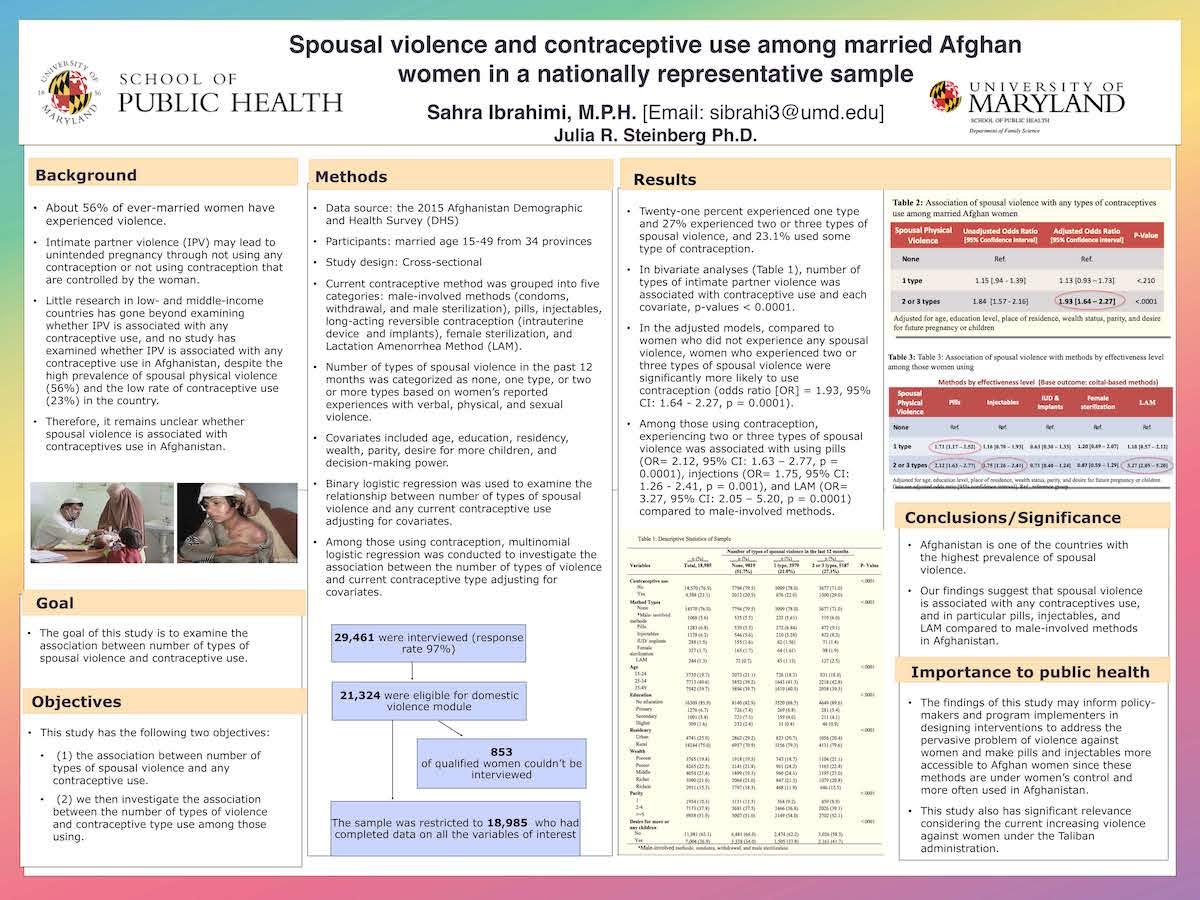
Poster # 28
Title: Spousal violence and contraceptive use among married Afghan women in a nationally representative sample
Presenting Author: Sahra Ibrahimi UMD SPH Doctoral Student in Family Science)
Faculty Mentor: Dr. Julia R. Steinberg
Primary Category: Family, Child, Adolescent Health (Includes Maternal and Child Health)
Secondary Category: None
Background: Intimate partner violence (IPV) may lead to unintended pregnancy through not using any contraception or not using contraception that are controlled by the woman (Maxwell et al., 2015). Little research in low- and middle-income countries has gone beyond examining whether IPV is associated with any contraceptive use, and no study has examined whether IPV is associated with any contraceptive use in Afghanistan, despite the high prevalence of spousal physical violence (56%) and the low rate of contraceptive use (23%) in the country (CSO & AfMoPH, 2017). Therefore, it remains unclear whether spousal violence is associated with contraceptives use in Afghanistan.
Goal: The goal of this study is to examine the association between number of types of spousal violence and contraceptive use.
Objectives: This study examines (1) the association between number of types of spousal violence and any contraceptive use; (2) we then investigate the association between the number of types of violence and contraceptive type use among those using.
Approach/Methods: Using data from 18,985 Afghan married women ages 15 to 49 who responded to the 2015 Afghanistan Demographic and Health Survey (AfDHS), current contraceptive method was grouped into five categories: male-involved methods (condoms, withdrawal, and male sterilization), pills, injectables, long-acting reversible contraception (intrauterine device and implants), female sterilization, and Lactation Amenorrhea Method (LAM). Number of types of spousal violence in the past 12 months was categorized as none, one type, or two or more types based on women’s reported experiences with verbal, physical, and sexual violence. Covariates included age, education, residency, wealth, parity, desire for more children, and decision-making power. Binary logistic regression was used to examine the relationship between number of types of spousal violence and any current contraceptive use. Among those using contraception, multinomial logistic regression was conducted to investigate the association between the number of types of violence and current contraceptive type.
Results: Twenty-one percent (n=3,979) experienced one type of spousal violence, 27% (n=5,187) experienced two or three types of spousal violence, and 23.1% (n=4,388) used some type of contraception. In the adjusted models, we found that compared to women who did not experience any spousal violence, women who experienced two or three types of spousal violence were significantly more likely to use contraception (odds ratio [OR] = 1.93, 95% CI: 1.64 - 2.27, p = 0.0001). Among those using contraception, women who experienced two or three types of spousal violence were more likely to use pills (OR= 2.12, 95% CI: 1.63 – 2.77, p = 0.0001), injections (OR= 1.75, 95% CI: 1.26 - 2.41, p = 0.001), and LAM (OR= 3.27, 95% CI: 2.05 – 5.20, p = 0.0001) compared to male-involved methods.
Importance to Public Health: Our findings suggest that spousal violence is associated with any contraceptives use, and in particular pills, injectables, and LAM compared to male-involved methods in Afghanistan. The findings of this study may inform policy-makers and program implementers in designing interventions to address the pervasive problem of violence against women and make pills and injectables more accessible to Afghan women since these methods are under women’s control and more often used in Afghanistan.
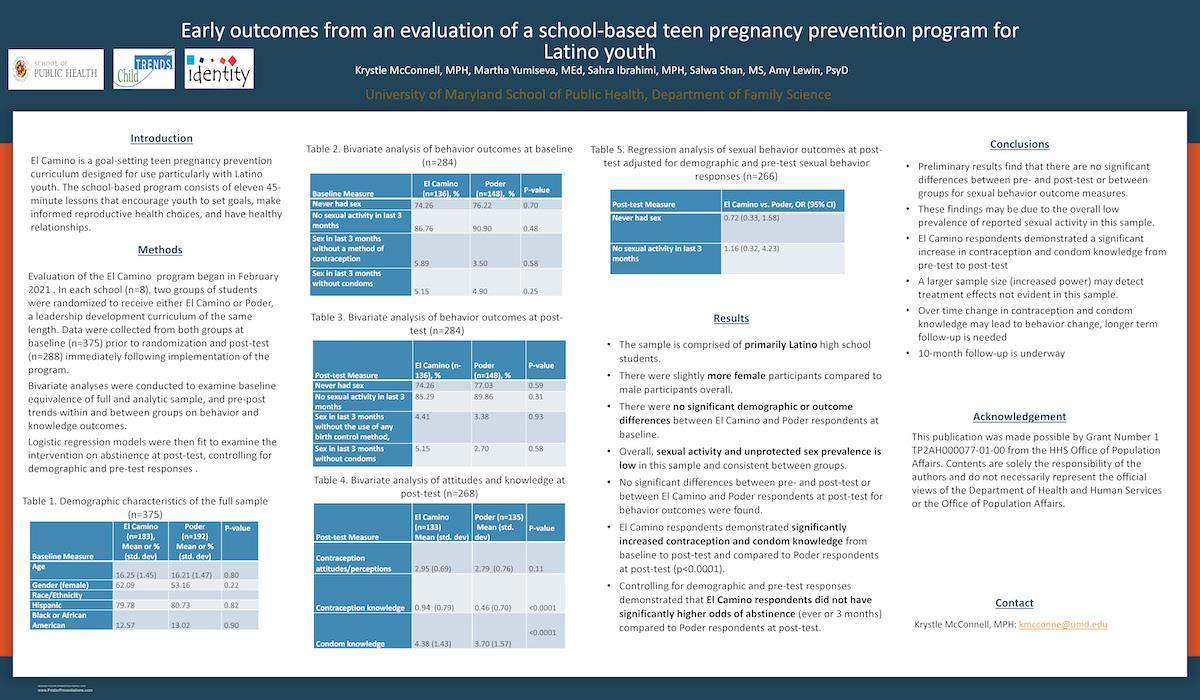
Poster # 29
Title: Early outcomes from an evaluation of a school-based teen pregnancy prevention program for Latino youth
Presenting Author: Krystle McConnell (UMD SPH Doctoral Student, Family SCince)
Authors: Martha Yumiseva, MEd, UMD SPH FMSC, PhD Candidate; Sahra Ibrahimi, MPH, UMD SPH FMSC, PhD Student; Salwa Shan, MS, UMD SPH FMSC, PhD Student; Amy Lewin, PsyD, UMD SPH FMSC, Faculty
Faculty Mentor: Dr. Amy Lewin
Primary Category: Family, Child, Adolescent Health (Includes Maternal and Child Health)
Secondary Category: None
Background: El Camino is a goal setting TPP curriculum designed particularly for Latino youth. The school-based program consists of eleven 45-minute lessons that encourage youth to set goals, make informed reproductive health choices, and have healthy relationships. Evaluation of the program began in February 2021 with a randomized controlled trial in eight high schools.
Goal: The school-based program consists of eleven 45-minute lessons that encourage youth to set goals, make informed reproductive health choices, and have healthy relationships.
Objectives:
- To describe the El Camino intervention.
- To compare preliminary outcomes between the El Camino participants and the control participants.
- To describe the implications of preliminary findings.
Approach/Methods: Data were collected from both groups at baseline prior to randomization and post-test immediately following implementation of the program. Bivariate analyses between treatment and control were conducted at baseline and post-test, and between pre- and post-test by treatment arm.
Results: The first three cohorts of students who completed the intervention (n =375) were primarily Hispanic (80%) and 70% were born outside of the US. At baseline, 24% reported having ever had penis-in-vagina sex. 9% of students reported being sexually active in the last 3 months, with 44% of those respondents reporting unprotected sex without any method of birth control and 47% reporting sex without using a condom. Knowledge about contraception and correct condom use was low overall, ranging from 87% who knew not to use a condom more than once to 46% who knew to leave space at the tip. Only about 1/3 of students had heard of contraception methods like the shot, patch, IUD, and implant. There were no significant differences between the groups on any of these variables at baseline. Preliminary bivariate analyses indicate that, at post-test (n=288), the group that received El Camino (n=139) were significantly more likely than the comparison group to have greater knowledge of correct contraception and condom use (p<0.0001).
Importance to Public Health: Preliminary results indicate that this teen pregnancy prevention program is effective in increasing awareness and knowledge around correct contraception and condom use, which may lead to longer-term behavior change. Long-term follow-up is underway.
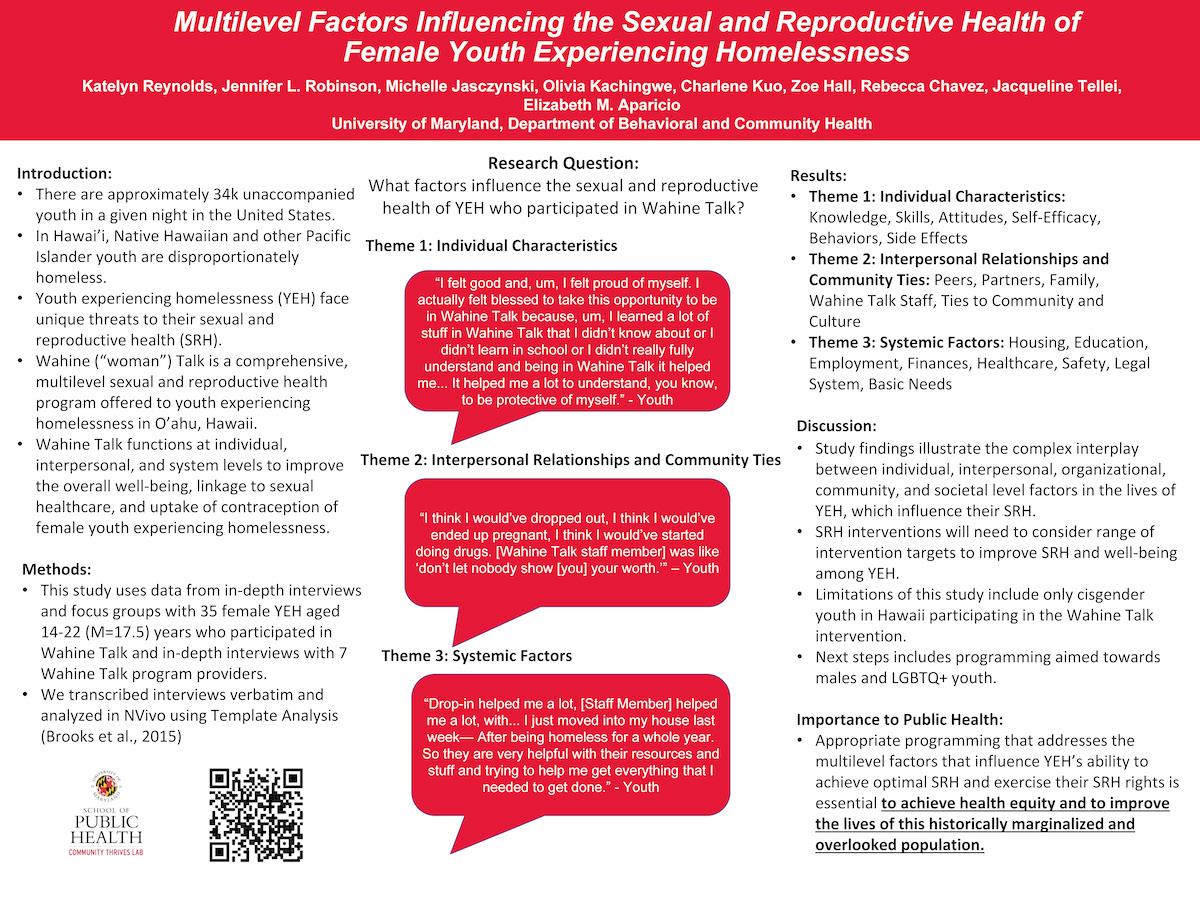
Poster # 30
Title: Multilevel Factors Influencing the Sexual and Reproductive Health of Female Youth Experiencing Homelessness
Presenting Author: Katelyn Reynolds (UMD Undergraduate Student, Biology)
Authors: Jennifer Robinson, School of Public Health, Department of Behavioral and Community Health, University of Maryland, Student; Michelle Jasczynski, School of Public Health, Department of Behavioral and Community Health, University of Maryland, Student; Olivia Kachingwe, Johns Hopkins University, Student; Charlene Kuo, School of Public Health, Department of Behavioral and Community Health, University of Maryland, Student; Zoe Hall, School of Public Health, Public Health Science, University of Maryland, Student; Rebecca Chavez, Waikiki Health, Youth Outreach, community partner; Jaqueline Tellei, Waikiki Health, PATH Clinic and Youth Outreach, community partner; Elizabeth Aparicio, School of Public Health, Department of Behavioral and Community Health, University of Maryland, faculty
Faculty Mentor: Dr. Elizabeth Aparicio
Primary Category: Family, Child, Adolescent Health (Includes Maternal and Child Health)
Secondary Category: Research on Health Disparities in Memory of Mitchell Stewart
Background: Few studies have assessed the multilevel factors affecting sexual and reproductive health (SRH) among youth experiencing homelessness (YEH) despite their importance in developing attuned interventions for this population. Wahine (“woman”) Talk is a multilevel, holistic SRH intervention for female YEH in Hawai’i.
Goal: The current study draws upon data from YEH and Wahine Talk program providers to apply the social-ecological model to the multilevel factors influencing SRH in YEH.
Objectives: What factors influence the SRH of YEH who participated in a comprehensive sexual and reproductive health program?
Approach/Methods: This study uses data from in-depth interviews and focus groups with 35 female YEH aged 14-22 (M=17.5) years who participated in Wahine Talk and in-depth interviews with seven Wahine Talk program providers. The data were transcribed verbatim and analyzed using template analysis. We coded the transcripts in NVivo using a codebook informed by the levels of the social-ecological model (e.g., individual, interpersonal, societal) then developed and refined themes and sub-themes reflecting youth and providers’ perceptions of multilevel factors influencing the SRH of YEH.
Results: Study findings illustrate the complex interplay between individual, interpersonal, organizational, community, and societal level factors in the lives of YEH, which influence their SRH. Lack of knowledge around safe sex and reproductive options affected youth’s ability to achieve optimal SRH and exercise their SRH rights. Youth were influenced by the attitudes of their partners and peers. They also described challenges of reconciling their own SRH decisions with the cultures, religions, traditions, and values of their families and communities. Overarching structural challenges such as access to basic needs, housing, education, employment, and safety permeate YEH’s lives and subsequently affect their SRH.
Importance to Public Health: Study findings illustrate that YEH face myriad challenges at multiple levels that impact their SRH. Thus, SRH programs must address these challenges to best serve these populations, including providing structural-level interventions to complement individual and interpersonal programming.
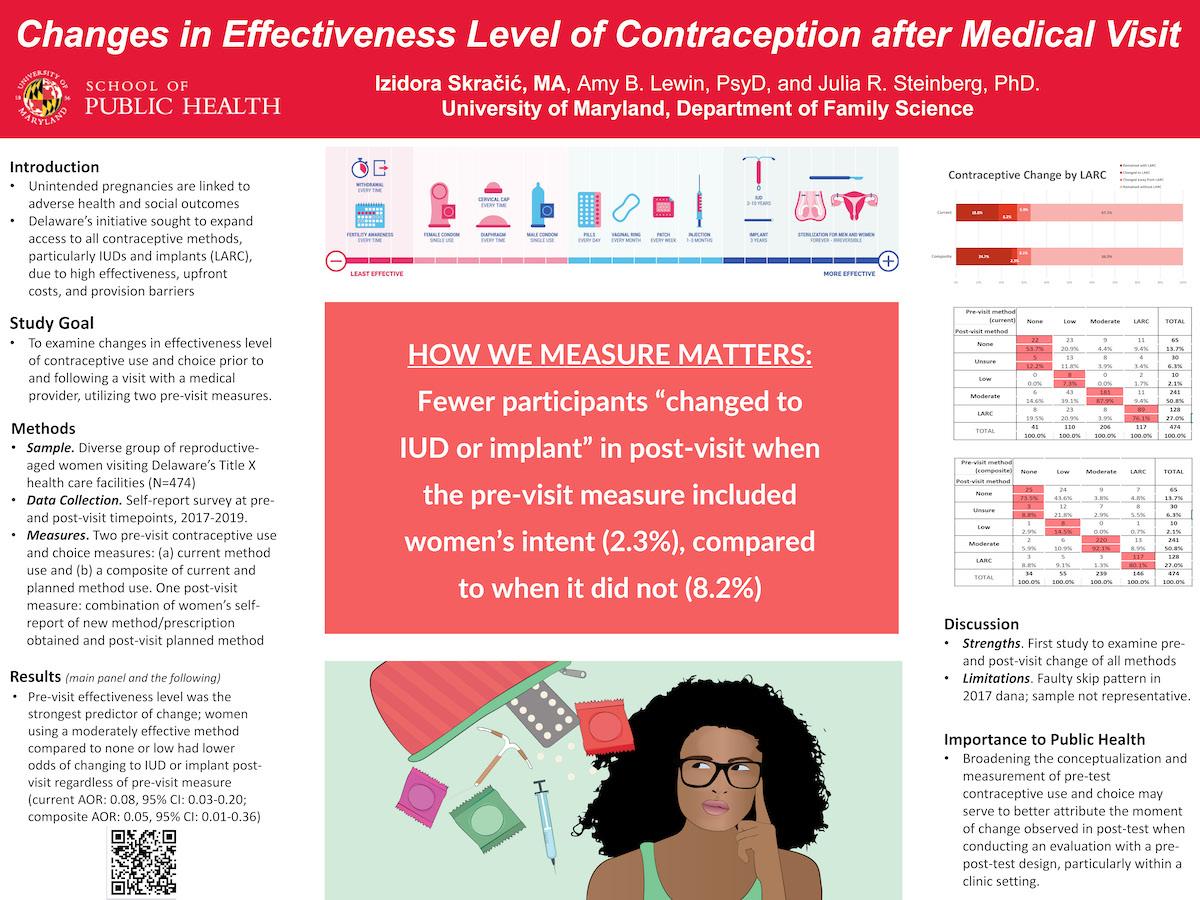
Poster # 31
Title: Changes in Contraceptive Intent after a Title X Provider Visit
Presenting Author: Izidora Skracic (UMD SPH Doctoral Student, family Science)
Authors: Amy B. Lewin, Family Science SPH, Faculty; Julia R. Steinberg, Family Science SPH, Faculty
Faculty Mentor: Dr. Julia R. Steinberg
Primary Category: Family, Child, Adolescent Health (Includes Maternal and Child Health)
Secondary Category: Health Care, Access to Care, Insurance, Technology
Background: Unintended pregnancies are consistently linked to negative health, social, and economic outcomes for both mother and child. Since not all contraceptive methods are equally effective, a Delaware public health initiative sought to expand statewide access to all contraceptive methods, particularly long-acting reversible contraception (LARC), such as IUDs and implants, due to their high effectiveness, upfront costs, and provision barriers.
Goal: This study examined changes in effectiveness level of self-reported contraceptive intention prior to and following a visit with a medical provider.
Objectives: The objective was to observe differences between two results when utilizing two different pre-visit measures that omit and include intent. The Integrated Behavioral Model posits that intent is an essential determinant of behavior.
Approach/Methods: A diverse group of women (N=474) were recruited at Title-X-funded primary care and women’s health clinics in Delaware. Two measures assessed self-reported pre-visit contraception: (a) current method use and (b) a composite of current and planned method use. A single post-visit measure combined women’s self-report of a new method/prescription obtained and post-visit planned method use. Participants reporting more than one method type in any measure were coded as the highest effective method, consistent with prior literature.
Results: Incorporating women’s contraceptive plan in the pre-visit composite measure resulted in fewer participants being categorized as switching to LARC (2.3%) after a provider visit, compared to the measure that only accounted for current contraceptive use (8.2%). In adjusted logistic regression models, pre-visit effectiveness level was the strongest predictor of change; women using a moderately effective method compared to none or low had much lower odds of changing to LARC post-visit regardless of the pre-visit measure used (current AOR: 0.08, 95% CI: 0.03-0.20; composite AOR: 0.05, 95% CI: 0.01-0.36).
Importance to Public Health: In line with the Integrated Behavioral Model, findings suggest that measuring contraceptive intention is key when applying a pre-post-test design to evaluate change, particularly within a clinic setting. Examining both the current and composite current-planned conceptualizations and measurements may provide more information to better understand pre-post changes in contraceptive intent.
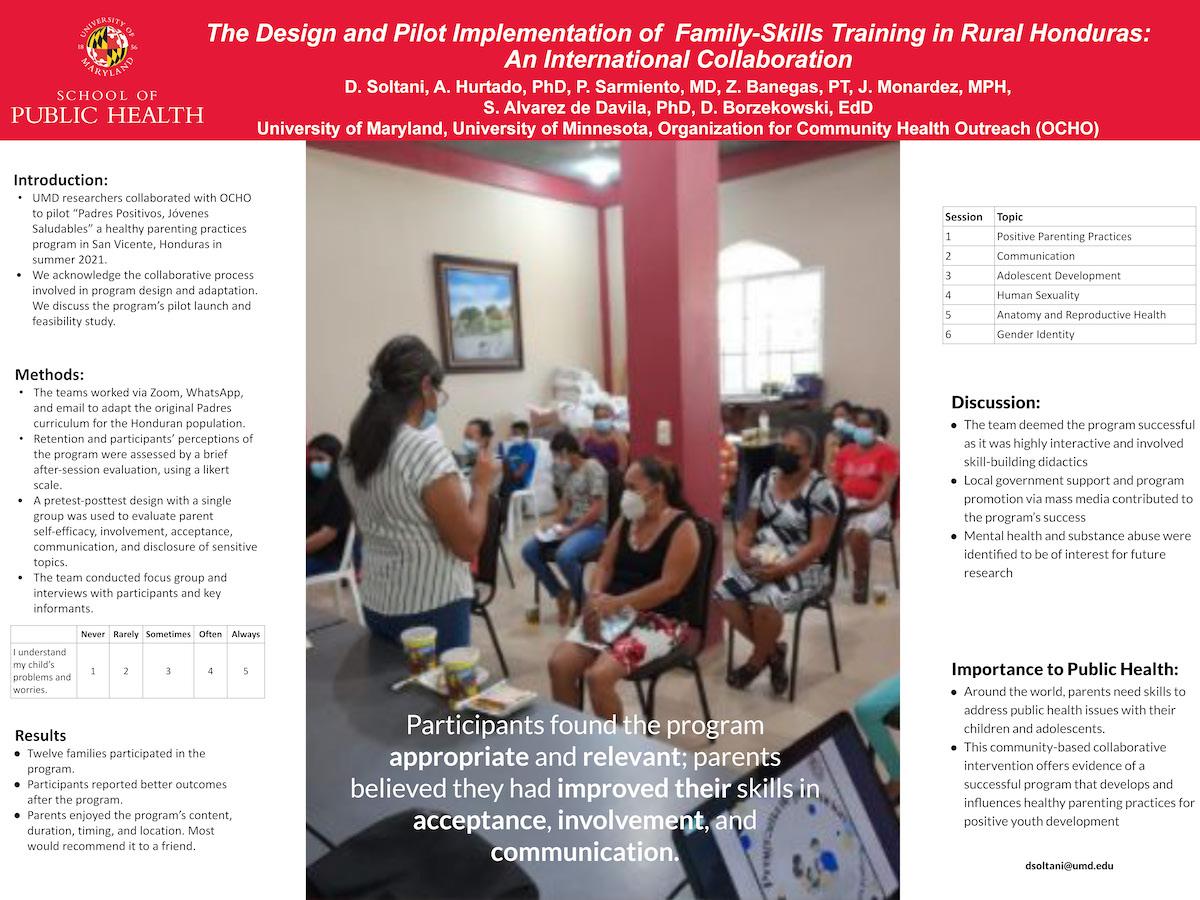
Poster # 32
Title: The Design and Pilot Implementation of a Family-Skills Training in Rural Honduras: An International Collaboration
Presenting Author: Darya Soltani (UMD SPH MAster's Student in Behavioral and Community Health)
Authors: Ali Hurtado, UMD, Faculty; Patrocinio Sarmiento, OCHO, community partner; Zasha Banegas, OCHO, community partner; Javiera Monardez, UMN,other; Silvia Alvarez de Davila, UMN, faculty; Dina Borzekowski, UMD, faculty
Faculty Mentor: Dr. Dina Borzekowski
Primary Category: Family, Child, Adolescent Health (Includes Maternal and Child Health)
Secondary Category: Behavioral Health, Mental Health, Substance Abuse
Background: Healthy parenting practices programs can foster positive youth development; however, there are limited programs in rural Honduras. UMD researchers collaborated with the Organization for Community Health Outreach (OCHO) to pilot and evaluate a program titled “Padres Positivos, Jóvenes Saludables” in San Vicente, Honduras.
Goal: This presentation describes the formative collaborative process of adaptation, and the pilot implementation of a family-skills program in rural Honduras.
Objectives: We offer information on the: (1) collaborative process of program design and adaptation, and (2) pilot and feasibility study of the program.
Approach/Methods: The team determined the community’s interests, strengths and needs via Zoom, WhatsApp, and email. The new and adapted program relied on the Padres Preparados curriculum, ensuring its cultural appropriateness and relevance to the audience. The adapted program topics included: (1) positive parenting practices, (2) communication, (3) adolescent development, (4) human sexuality, (5) anatomy and reproductive health, and (6) gender identity. The team assessed retention and the participants’ perceptions with an after-session evaluation, using a Likert scale. Additionally, the team used a one-group pretest-posttest design, measuring parenting self-efficacy, involvement, acceptance, communication, and disclosure of sensitive topics. Analysis included descriptive statistics and paired t-tests to measure change in parenting outcomes. Following the intervention, the team conducted group interviews with participants and key informants. Content and thematic analysis were conducted.
Results: Twelve families, mothers and their adolescents, youth between the ages of 10-14, participated in the program. Participants found the program appropriate and relevant and believed they had improved skills in acceptance, involvement and communication. Interviews revealed that parents enjoyed the content, duration, timing, and location; most would recommend the program to others. The team deemed the program successful as it was interactive and included skill-building didactics. Additionally, the local government supported the program logistically and promoted it through mass media. It was recommended that future program topics include mental health and substance abuse.
Importance to Public Health: International collaboration is critical to address public health concerns. This community-based collaborative intervention is the early stages of an evidence-based program that can develop and influence healthy parenting practices for positive youth development.
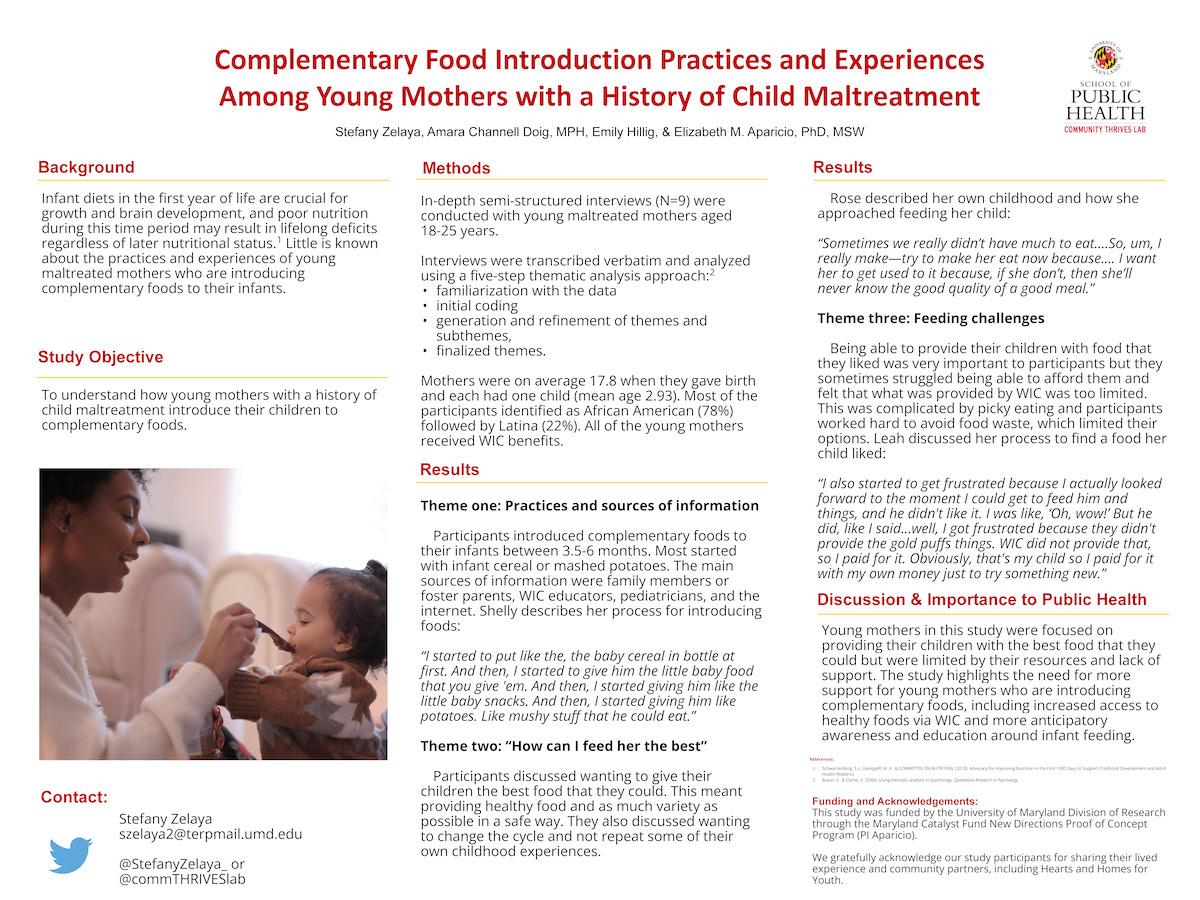
Poster # 33
Title: Complementary Food Introduction Practices and Experiences Among Young Mothers with a History of Maltreatment
Presenting Author: Stefany Zelaya (UMD SPH Undergraduate Student, Public Health Science)
Authors: Amara Channell Doig, MPH, University of Maryland Behavioral and Community Health Department PhD Student; Emily Hillig, University of Maryland student in Food and Nutrition Program; Elizabeth M. Aparicio, PhD, MSW, University of Maryland Behavioral and Community Health Department, Faculty
Faculty Mentor: Dr. Elizabeth M. Aparicio
Primary Category: Family, Child, Adolescent Health (Includes Maternal and Child Health)
Secondary Category: None
Background: Infant diets in the first year of life are crucial for growth and brain development, and poor nutrition during this time period may result in lifelong deficits regardless of later nutritional status. Little is known about the practices and experiences of young maltreated mothers who are introducing complementary foods to their infants.
Goal: To determine the parenting and mental health needs of young mothers with a history of maltreatment.
Objective: To understand how young mothers with a history of child maltreatment introduce their children to complementary food.
Approach/Methods: In-depth semi-structured interviews (N=9) were conducted with young maltreated mothers aged 18-25 years. Interviews were transcribed verbatim and analyzed using a five-step thematic analysis approach:2 familiarization with the data initial coding generation and refinement of themes and subthemes, finalized themes. Mothers were on average 17.8 when they gave birth and each had one child (mean age 2.93). Most of the participants identified as African American (78%) followed by Latina (22%). All of the young mothers received WIC benefits.
Results: Theme one: Practices and sources of information
Participants introduced complementary foods to their infants between 3.5-6 months. Most started with infant cereal or mashed potatoes. The main sources of information were Family members or foster parents, WIC, Pediatricians, and the internet.
Theme two: “How can I feed her the best”
Participants discussed wanting to give their children the best food that they could. This meant providing healthy food and as much variety as possible in a safe way. They also discussed wanting to change the cycle and not repeat some of their own childhood experiences.
Theme three: Feeding Challenges
Being able to provide their children with food that they liked was very important to participants but they sometimes struggled being able to afford them and felt that what was provided by WIC was too limited. This was complicated by picky eating and participants worked hard to avoid food waste which limited their options.
Importance to Public Health: Young mothers in this study were focused on providing their children with the best food that they could but were limited by their resources and lack of support. The study highlights the need for more support for young mothers who are introducing complementary foods, including increased access to healthy foods via WIC and more anticipatory awareness and education around infant feeding.